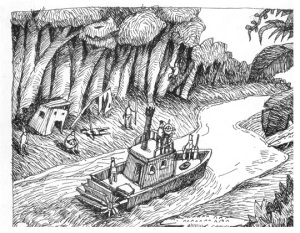Heart of Darkness
Consider the importance of setting in any one text – The Heart of Darkness
(689 words)
Joseph Conrad’s The Heart of Darkness is not a story without its settings; the nightmarish journey of Charlie Marlowe (our narrator) into the unknown where we find ourselves traveling by boat to and in the Belgium Congo in 1890. The use of this setting shows and explains the exploitation of a colonial country and challenges the basic ethical question of good and evil of mankind. Marlowe’s setting is perfectly placed to give the reader a glimpse of the political environment of the Congo and the African exploration that was quite popular in Conrad’s day.
Although most of the action in The Heart of Darkness is set in the uncivilized jungles of the African Congo, the tale itself is narrated by Charlie, an experienced sailor aboard a pleasure boat with four other Englishmen as they lounge on the deck at the mouth of the Thames River outside London. Charlie sits Buddha-like to narrate his story. Here, the reader gets a glimpse of the Thames as a mighty river at sunset with the gauzy radiant lights of civilized London, which reflect on the river’s surface. This is represented where both the time of day and the spot are significant. It’s sunset. As the tale turns gloomier, images of darkness get more and more pervasive. The evening grows gradually darker, so that by the time Marlow finishes, late in the night, his listeners have literally been enveloped in darkness.
Discuss the ways in which attraction and revulsion are linked in one text
(789 Words)
In Joseph Conrad’s Heart of Darkness, we find the protagonist Marlow, a man of adventure having sailed many a sea living in an era of the Victorian explorer David Livingstone who had not long returned from his African expedition in 1890. This is where tales of African exploration were told of different lands; those inquisitive minds couldn’t help but see the attraction of Livingstone’s journeys to this continent. Accompanied with this, is this new found land that is the reverse of Marlowe’s attraction to see Africa, it is where he gets a candid look at the reality of colonisation and imperialism. The journey for him finds the attraction and revulsion of it all.
In the opening scene, we see Marlow as the only one on the boat who still “follows the sea”. This seaman still sees the appeal of the open rivers and seas. He is a “wanderer”. Maps have always fascinated him, the blank spots, and those places yet explored. He wants to explore the inner Africa, the place associated with darkness. He wants to travel further into the long Congo, a captivating and extremely life-threatening river that lies like an immense snake. He remarks of the river that it is like traveling to the earliest beginnings of the world, the brilliant sunlit land offers ‘no joy’ but a “treacherous appeal”.



